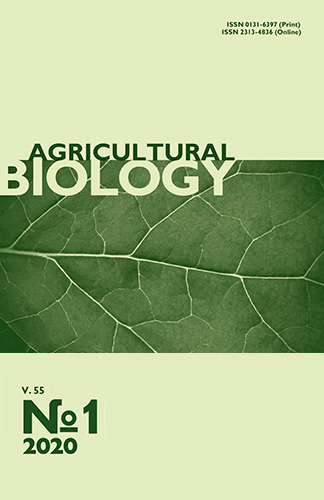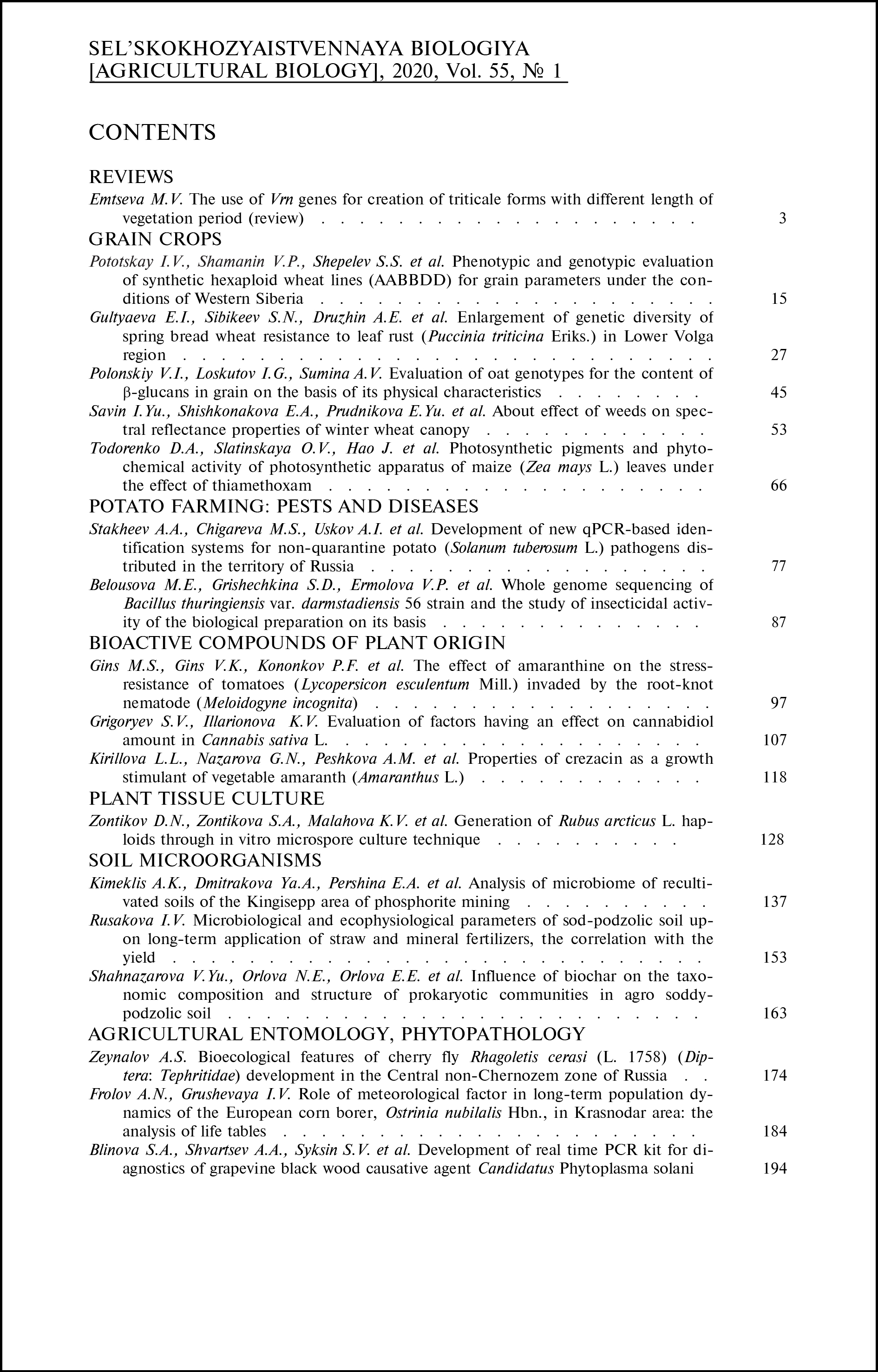doi: 10.15389/agrobiology.2020.1.53eng
UDC: 633.11:632.51:631.54:632.08:535.3
Acknowledgements:
Supported financially by Russian Foundation for Basic Research, grant No. 18-016-00052, and by Ministry of Science and Higher Education of the Russian Federation (agreement № 05.607.21.0302)
ABOUT EFFECT OF WEEDS ON SPECTRAL REFLECTANCE PROPERTIES OF WINTER WHEAT CANOPY
I.Yu. Savin1, 2, E.A. Shishkonakova1, E.Yu. Prudnikova1, 2, G.V. Vindeker1, P.G. Grubina1, D.V. Sharychev1, V.N. Schepotiev1, Yu.I. Verniuk1, 2, A.V. Zhogolev1
1Dokuchaev Soil Science Institute, Pyzhyovskii per. 7/str. 2, Moscow, 119017 Russia, e-mail savin_iyu@esoil.ru (✉ corresponding author), shishkonakova_ea@esoil.ru, prudnikova_eyu@esoil.ru, vindeker_gv@esoil.ru, grubina_pg@esoil.ru, sharychev_dv@esoil.ru, schepotiev_vn@esoil.ru, verniuk_yui@esoil.ru, zhogolev_av@esoil.ru;
2Agrarian and Technological Institute RUDN, ul. Miklukho-Maklaya 8/2, Moscow, 117198 Russia
ORCID:
Savin I.Yu. orcid.org/0000-0002-8739-5441
Sharychev D.V. orcid.org/0000-0002-6799-3209
Shishkonakova E.A. orcid.org/0000-0003-4396-2712
Schepotiev V.N. orcid.org/0000-0002-6276-5637
Prudnikova E.Yu. orcid.org/0000-0001-7743-8607
Verniuk Yu.I. orcid.org/0000-0002-3621-8330
Vindeker G.V. orcid.org/0000-0002-0463-4241
Zhogolev A.V. orcid.org/0000-0003-2225-7037
Grubina P.G. orcid.org/0000-0001-6325-4604
Received October 10, 2019
Among the poorly studied factors affecting the spectral reflectivity of crops and, consequently, the success of detection of their condition based on remote sensing data is crop weedness. On the basis of field survey data, the effect of weed infestation on winter wheat spectral reflectivity at different stages of vegetation was analyzed using the example of individual fields in the Tula region with chernozems, grey forest, and alluvial arable soils. Under field conditions, crop weedness, spectral reflectance of crops, weeds, winter wheat leaves and soil was determined using FieldSpec® HandHeld 2™ field spectro-radiometer (ASD, Inc., USA) was assessed several times during the growing season, and the crop surface was photographed. The decoding of the photos showed that the projective weed coverage on the crop surface is low enough at the beginning and middle of the wheat growing season, but increases significantly since the beginning of leaves yellowing. At the same time, the projective coverage of weeds in the field with chernozems was minimal at the beginning and middle of the growing season, and maximal - by the end of the growing season. Projective coverage of weeds on fields with grey forest and alluvial arable soils did not differ statistically, but on alluvial soils it increased significantly by the end of wheat vegetation. Using the spectral mixing model, the contribution of weeds infestation to the integral reflection of light by crops in the visible and near infrared bands of the electromagnetic waves was estimated. It has been found that despite the rather high weedness of winter wheat canopy in the spring-summer growing season, its projective coverage on the surface of the crop canopy is small. The magnitude of the projective cover of weeds on the surface of crop canopy weakly depends on soil conditions, and is more determined by other factors (history of fields use, crop rotation, etc.). The effect of weed vegetation on the spectral reflectivity of crops changes over time. It is minimal at the peak of the growing season, accounting for several percent for all wavelengths of the visible and near IR range. At the beginning of the post-winter vegetation period, the contribution of weed vegetation to the spectral reflectance of crops can reach 10–20 %, and at the end of the vegetation season, weed vegetation can predetermine the spectral appearance of crops at most wavelengths of the considered range. The greatest contribution is observed in all cases in the near IR (710-730 nm) and in the green (520-560 nm) spectral region, but at certain times there are local maxima of the contribution and in the blue spectral region of electromagnetic waves (400–420 nm). The data obtained open up the possibility for the development of new vegetation indices for remote monitoring of crops, which will be less affected by weedness than those traditionally used (for example, NDVI). Conversely, on the basis of the data obtained, special vegetation indices can be proposed for the remote detection of the weedness of winter wheat canopy.
Keywords: spectral reflectance, Tula region, crop weedness, winter wheat, remote sensing monitoring of crops.
REFERENCES
- Razvitie sel'skokhozyaistvennoi meteorologii v Rossii. Pod redaktsiei I.G. Gringofa, A.D. Kleshchenko [Agricultural meteorology in Russia. I.G. Gringof, A.D. Kleshchenko (eds.)]. Obninsk, 2009 (in Russ.).
- Gringof I.G., Fedorova Z.S., Belolyubtsev A.I., Malakhova S.D. Praktikum po agrometeorologii. Chast' I. Meteorologicheskie izmereniya i nablyudeniya. Chast' II. Agrometeorologicheskie izmereniya i nablyudeniya [Workshop on agrometeorology. Part I. Meteorological measurements and observations. Part II Agrometeorological measurements and observations]. Obninsk, 2018 (in Russ.).
- Ennouri K., Kallel A. Remote sensing: an advanced technique for crop condition assessment. Mathematical Problems in Engineering, 2019, 2019: Article ID 9404565 CrossRef
- Tolpin V.A., Bartalev S.A., Efremov V.Yu., Lupyan E.A., Savin I.Yu., Flitman E.V. Sovremennye problemy distantsionnogo zondirovaniya Zemli iz kosmosa, 2010, 7(2): 221-232 (in Russ.).
- Savin I.Yu., Nègre T. Agro-meteorological monitoring in Russia and Central Asian countries. Ispra, OPOCE, 2006.
- Becker-Reshef I., Justice C., Sullivan M., Vermote E., Tucker C., Anyamba A., Small J., Pak E., Masuoka E., Schmaltz J., Hansen M., Pittman K., Birkett C., Williams D., Reynolds C., Doorn B. Monitoring global croplands with coarse resolution earth observations: the Global Agriculture Monitoring (GLAM) project. Remote Sensing, 2010, 2(6): 1589-1609 CrossRef
- Wu B., Meng J., Li Q., Yan N., Du X., Zhang M. Remote sensing-based global crop monitoring: experiences with China's CropWatch system. International Journal of Digital Earth, 2014, 7(2): 113-137 CrossRef
- Savin I. Crop yield prediction with SPOT VGT in Mediterranean and Central Asian countries. In: ISPRS Archives XXXVI-8/W48 Workshop proceedings: Remote sensing support to crop yield forecast and area estimates. Commission VIII, WG VIII/10. OPOCE, Stresa, 2007: 130-134.
- Rembold F., Atzberger C., Savin I., Rojas O. Using low resolution satellite imagery for yield prediction and yield anomaly detection.Remote Sensing,2013, 5(4): 1704-1733 CrossRef
- Bereza O.V., Strashnaya A.I., Lupyan E.A. Sovremennye problemy distantsionnogo zondirovaniya Zemli iz kosmosa, 2015, 12(1): 18-30 (in Russ.).
- Savin I.Yu., Vernyuk Yu.I., Faraslis I. Byulleten' Pochvennogo instituta im. V.V. Dokuchaeva, 2015, 80: 95-105 CrossRef (in Russ.).
- Savin I.Yu. V sbornike: Primenenie sredstv distantsionnogo zondirovaniya zemli v sel'skom khozyaistve [In: The use of remote sensing of land in agriculture]. St. Petersburg, 2015: 29-32 (in Russ.).
- Menges R.M., Nixon P.R., Richardson A.J. Light reflectance and remote sensing of weeds in agronomic and horticultural crops. Weed Science, 1985, 33(4): 569-581 CrossRef
- Thorp K., Tian L.F. A review on remote sensing of weeds in agriculture. Precision Agriculture, 2004, 5(5): 477-508 CrossRef
- Zakharenko V.A. Agrokhimiya, 1997, 3: 67-74 (in Russ.).
- Petit S., Boursault A., Guilloux M., Munier-Jolain N., Reboud X. Weeds in agricultural landscapes. A review. Agronomy for Sustainable Development, 2011, 31(2): 309-317 CrossRef
- Sineshchekov V.E., Vasil'eva N.V. Vestnik NGAU (Novosibirskii gosudarstvennyi agrarnyi universitet), 2017, 4: 32-40 (in Russ.).
- Lamba D.W., Brown R.B. PA — precision agriculture: remote-sensing and mapping of weeds in crops. Journal of Agricultural Engineering Research, 2001, 78(2): 117-125 CrossRef
- Martin M. P., Barreto L., Riaño D., Fernandez-Quintanilla C., Vaughan P. Assessing the potential of hyperspectral remote sensing for the discrimination of grassweeds in winter cereal crops. International Journal of Remote Sensing, 2011, 32(1): 49-67 CrossRef
- Pflanz M., Nordmeyer H., Schirrmann M.Weed mapping with UAS Imagery and a Bag of Visual Words based image classifier. Remote Sensing, 2018, 10(10): 1530 CrossRef
- Noble S., Brown R., Crowe T. The use of spectral properties for weed detection and identification —a review. Presentation at the AIC 2002 Meeting CSAE/SCGR Program Saskatoon, Saskatchewan, July 14-17, 2002. Saskatoon, 2002: Paper No. 02-208.
- Vrindts E.J. De Baerdemaeker J., De Baerdemaeker, Ramon H. Weed detection using canopy reflection. Precision Agriculture, 2002, 3(1): 63-80 CrossRef
- Che’Ya N., Gupta M., Doug G., Lisle A., Basnet B., Campbell G. Spectral discrimination of weeds using hyperspectral radiometry. Proceedings of the 5th Asian Conference on Precision Agriculture (ACPA), June 25-28, 2013, Jeju, Korea. Jeju, 2013: 325.
- Mal'tsev A.I. Sornaya rastitel'nost' SSSR i mery bor'by s neyu [Weed vegetation and its combating in the USSR]. Leningrad, 1936 (in Russ.).
- Alekhin V.V. Metodika polevogo izucheniya rastitel'nosti i flory [Methods of field study of vegetation and flora]. Moscow, 1938 (in Russ.).
- Ponyatovskaya V.M. V knige: Polevaya geobotanika. Tom III. Pod redaktsiei E.M. Lavrenenko, A.A. Korchagina [In: Field geobotany. Vol. III. E.M. Lavrenenko, A.A. Korchagin (eds.)]. Moscow-Leningrad, 1964: 209-290 (in Russ.).
- Beideman I.N. V knige: Polevaya geobotanika. Tom II. Pod redaktsiei E.M. Lavrenenko, A.A. Korchagina In: Field geobotany. Vol. II. E.M. Lavrenenko, A.A. Korchagin (eds.)]. Moscow-Leningrad, 1960: 333-366 (in Russ.).
- Growth stages of mono- and dicotyledonous plants. BBCH Monograph. U. Meier (ed.). Federal Biological Research Centre for Agriculture and Forestry 2001.
- Savitzky A., Golay M.J.E.Smoothing and differentiation of data by simplified least squares procedures. Analytical Chemistry, 1964, 36(8): 1627-1239 CrossRef
- Weiss M., Baret F., Myneni R.B., Pragnère A., Knyazikhin Y. Investigation of a model inversion technique to estimate canopy biophysical variables from spectral and directional reflectance data. Agronomie, 2000, 20(1): 3-22 CrossRef
- Maevskii P.F. Flora srednei polosy evropeiskoi chasti Rossii [Flora of the middle zone of the European part of Russia].Moscow, 2014 (in Russ.).
- Savin I.Yu., Dokukin P.A., Vernyuk Yu.I., Zhogolev A.V. Sovremennye problemy distantsionnogo zondirovaniya Zemli iz kosmosa, 2017, 14(3): 185-195 CrossRef (in Russ.).
- Verstraete M.M. Radiation transfer in plant canopies — transmission of direct solar radiation and the role of leaf orientation. Journal of Geophysical Research, 1987, 92(D9): 10985-10995 CrossRef
- Merotto A. Jr., Bredemeier C., Vidal R.A., Goulart I.C.G.R., Bortoli E.D., Anderson N.L. Reflectance indices as a diagnostic tool for weed control performed by multipurpose equipment in precision agriculture. Planta Daninha, 2012, 30(2): 437-447 CrossRef
- Abouziena H.F., El-Saeid H.M., Amin A.A.E. Water loss by weeds: a review. International Journal of ChemTech Research, 2014, 7(01): 323-336.
- Zimdahl R.L. Fundamentals of weed science. Elsevier Inc., 2018 CrossRef












